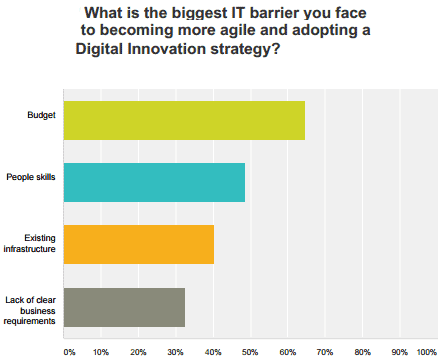Retailers, often hampered by legacy systems, have to change how they approach development if they are to innovate and succeed in digital innovation.
The retail industry is going through one of its most exciting phases of development since the birth of ecommerce, and the potential that digital innovation offers for retail businesses is explosive. New technology and the continuous desire to innovate and do even more to improve the customer experience is winning hearts, minds and wallets of customers and improving retailers’ bottom lines as a result.
For the newest retailers – especially those whose very businesses have focussed on agile, fast development to succeed such as ASOS and Amazon — that is easy. These are businesses that have been built with agile structures and quick fire development cycles.
For others it’s not so simple. “The biggest challenges to digital innovation are legacy, lack of imagination and not creating space for it within the organisation,” says Shoes of Prey co-founder and chief creative officer Jodie Fox, who admits she is lucky to have very little legacy within her business.
Our survey showed that for more than half of respondents (53%) infrastructure modernisation was an area of increasing investment for their business as they sought to update legacy systems.
FreestyleXtreme, at 14 years of age, is a newer player than some of its high street equivalents but has still had to deal with the frustrations and challenges of legacy systems within its business. “We really struggled and still struggle with legacy systems,” says FreestyleXtreme co-founder and marketing director Ben Robert Richardson. “It has always been an office joke that we are a donkey trying to compete in the Grand National,” he says. However that has changed over the last five years thanks to employing the right people and systems, he says. Within months the company’s transformation will be complete. “By early next year we will have overhauled everything. Where this has happened [already] we now have agility in the business to meet changing demands,” he says.
At New Look legacy is a problem but the company’s digital director Jack Smith says the retailer is making progress in its evolution, although he warns that retailers have to think beyond simply the IT platform and think processes too. “Some of the challenges will be unlocked when we move to new platforms but the thing that people always underestimate with moving to a new model of delivery is that it’s not just an IT issue it’s a lot of business change,” he says.
“I’m a massive advocate of optimisation and continuous development is a way of delivering on that but we have to build out on optimisation first. It’s only when you have that solid pipeline of work that you then need the factory that can go through and deliver the change to the actual website,” says Smith.
He admits it’s a challenge for most high street businesses. “I think I’m yet to see anyone who has got it done really well but we are doing a good job as an industry of moving to where we want to get to,” says Smith. “We need to get to a continuous rather than project view of innovation,” he says.
ShopDirect’s head of user experience Sam Barton says agility is key to being able to deliver innovation. “It’s really important that innovation is built into everything we do. Technology is evolving and customers’ behaviours are changing so quickly that you always have to be on your toes and set yourself up with as much agility as possible to adapt to changes in the market,” he says.
At Boots UK part of the function of the company’s Betalab, established earlier this year, was to give it the kind of flexibility of development that hasn’t necessarily been possible in the larger business “One of the reasons why we set up the Betalab was so that we can genuinely adopt an agile development strategy,” says Robin Phillips, director of omnichannel and development for Boots UK.
“We need to learn and move very quickly in a way that we have not been able to do before so we can use that agile development as a training ground for the rest of the business and the rest of the IT team to show how we can work. It redefines the art of what’s possible for the team and allows you to operate at a pace that you couldn’t otherwise do,” says Phillips.
Home Retail Group also has a strong focus on moving from a legacy to an agile environment as part of its Argos Transformation Plan and is replacing an outdated complex infrastructure with a new comprehensive digital architecture that will allow it to better innovate in the future. This move to an agile capability will allow it to develop customer experiences across digital devices.
The Home Retail Group admits that this is the largest element of its investment programme and also the most complex change to make. New online payment and content management systems have already been introduced whilst real-times stock visibility across the company’s hub and spoke store network has also improved the customer experience.
The retailer admits it’s no easy task with some critical components of the infrastructure still to be developed and introduced. It has also admitted that it has faced a bigger challenge in making the infrastructure move than it had anticipated with extreme online volumes and volatility during the trading year putting unanticipated pressure on the resilience and scalability of its existing systems.
It’s easy in fact for even the largest retailers to underestimate the scale of change projects require when moving from legacy environments to more agile environments. In 2014 the launch of M&S’ new website was a major project that it admitted faced initial performance issues and that the bedding down period of the site was tougher than expected.
Finding the budget and resources to innovate is also challenging as highlighted by our survey in which 59% said that lack of resources and budget restricted their ability to innovate further. That was followed by the fact that such projects can take too long (36%) proving a distraction from normal day to day business.
As ever budget proved the biggest IT barrier to becoming more agile and adopting a digital innovation strategy with 64% citing it as one of the biggest IT barriers they faced.
This has to change. “Driving realignment of traditional costs on infrastructure and people to technologies and capabilities that will deliver an agile capability is key if IT is to overcome the challenges of static and decreasing budgets,” says James Spafford, director of Northern Europe for Delphix.
The birth of the continuous job title (and what that means for retailers) and the move to a DevOps environment
You’ve got to love the IT industry for its reinvention of job titles. Remember the humble IT director? You could be hard pressed to find one today. There are instead an abundance of roles that have been created in recent years as IT departments struggle to keep up with an industry that is often developing faster than they can create new job titles.
In the world of retail it’s little different. IT directors have become chief information officers. Ecommerce heads have evolved to become omnichannel directors with ecommerce director now just sometimes a division of a bigger department that the ecommerce director once ruled.
Retailers are reinventing their IT teams and ensuring they work more closely together with other important parts of the business –such as ecommerce and marketing – to deliver as full and complementary an experience as possible.
But retailers are also building talent in-house too with retailers increasingly investing in the kind of IT talent they would have previously outsourced, building innovation hubs for example. M&S last year invested heavily on building and bringing in-house its software engineering team in order to be able to react quicker than ever to change.
As businesses across industry change to react faster than ever to customer change, demand and the general forward thinking nature of business today then so retailers are having to follow suit too and look at new approaches such as continuous delivery – producing software in short cycles that enable them to be released at any time.
Our survey showed that few were yet hitting this point. Half of retailers said that they operated on a monthly release/update cycle whilst just under a third (31%) worked on a once a quarter or less update cycle. Only 8% were managing weekly updates and 6% daily.
Such patterns need to change. “It doesn’t matter if you are a traditional retailer or a new one, the need to provide continuous delivery on key customer facing applications is becoming the norm. Once a quarter or even once a month are no longer the desired state….daily and weekly are the new industry benchmark,” says Spafford.
This is especially important given the growing number of platforms that retailers are developing for. Our survey showed that most retailers (46%) were developing for between three and five consumer facing platforms. However 12% were developing for up to ten and 15% for more than ten.
Many retailers seem somewhat frustrated by their ability to innovate with 37% moderately happy in their ability to go from commercial idea to deployment. This compared to only 11% who were very happy that all commercial ideas could be deployed in time to positively impact that customer.
This suggests that a move on from agile environments to a DevOps strategy, where the development and operations teams work more closely than ever, is even more important to better deliver change and avoid being leapfrogged by disruptors in their industry. The survey showed that 20% of respondents were already using the DevOps philosophy in some specific projects and 15% were using it across their organisation. Nearly a quarter (23%) were investigating the potential of DevOps in order to ensure a closer collaboration of development and operations to speed up reaction times.
“Retailers don’t know what’s around the corner and so need to have the ability to offer change at the touch of a button and so need to be reactive to do so,” says Spafford.






